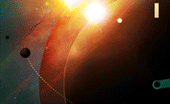News / Press Releases
Printer-friendly versionEuropean VLBI Network to participate in "100 Hours of Astronomy" with live webcast and e-VLBI observations
Update: The archived webcast can now be viewed online at http://www.ustream.tv/recorded/1336875.
DWINGELOO, the Netherlands (16 March 2009) - The European VLBI Network (EVN) will showcase the e-VLBI astronomical technique in the "100 Hours of Astronomy" with a live webcast on Friday 3 April and e-VLBI observations on Friday 3 April and Sunday 5 April. "The 100 Hours of Astronomy" is a cornerstone project of the International Year of Astronomy.
 The live webcast will take place at approximately 17:20 CET (15:20 GMT) and can be viewed at http://www.100hoursofastronomy.org/. As part of the "Around the World in 80 Telescopes, Live 24-hour Research Observatory Webcasts", a collection of 20-minute webcasts from observatories around the world, it will feature an overview of VLBI and e-VLBI astronomy techniques, discussion of the e-VLBI observations taking place, and a live Q&A session with Huib Jan van Langevelde, director for the Joint Institute for VLBI in Europe (JIVE) and Arpad Szomoru, Head of Technical Operations and R&D at JIVE.
The live webcast will take place at approximately 17:20 CET (15:20 GMT) and can be viewed at http://www.100hoursofastronomy.org/. As part of the "Around the World in 80 Telescopes, Live 24-hour Research Observatory Webcasts", a collection of 20-minute webcasts from observatories around the world, it will feature an overview of VLBI and e-VLBI astronomy techniques, discussion of the e-VLBI observations taking place, and a live Q&A session with Huib Jan van Langevelde, director for the Joint Institute for VLBI in Europe (JIVE) and Arpad Szomoru, Head of Technical Operations and R&D at JIVE.
14 telescopes in Australia, Chile, China, Finland, Germany, Italy, the Netherlands, Poland, Puerto Rico, Spain, Sweden and the UK are expected to participate in the e-VLBI observations. They will observe an active galaxy called 3C120, as well as quasars 0727-115 and 0234+285. Data from all the telescopes will be streamed electronically to JIVE in the Netherlands where it will be processed in real-time by a purpose-built supercomputer called a correlator. This technique, called electronic, real-time Very Long Baseline Interferometry or e-VLBI, is capable of producing images of cosmic radio sources with up to one hundred times better resolution than images from the best optical telescopes.
JIVE has also developed an educational web site for the International Year of Astronomy. This site, at http://iya.expres-eu.org/, explains the basic concepts of radio astronomy, interferometry and e-VLBI. Site visitors can also play with a Virtual Radio Astronomer to see first-hand how different combinations of telescopes and telescope settings affect the astronomical images produced.
These e-VLBI observations are made possible by the Express Production Real-time e-VLBI Service (EXPReS) and the cooperation of participating radio observatories and National Research and Education Networks. Funded by the European Commission, EXPReS has been working since 2006 to connect radio telescopes around the world with the correlator at JIVE using high-speed optical networks.
# # #
About the EVN
The European VLBI Network (EVN, www.evlbi.org) is a collaboration of the major radio astronomical institutes in Europe, Asia and South Africa that conducts unique, high resolution, radio astronomical observations of cosmic radio sources. It is the most sensitive VLBI array in the world, thanks to the collection of extremely large telescopes that contribute to the network.
About JIVE
The Joint Institute for VLBI in Europe (JIVE, www.jive.nl) is a scientific foundation with a mandate to support the operations of the European VLBI Network (EVN). For this purpose it maintains, operates and develops the MKIV EVN Data Processor, a powerful supercomputer that combines the signals from radio telescopes located across the planet. Through this technique, called Very Long Baseline Interferometry (VLBI), astronomers can make detailed images of cosmic radio sources, providing astronomers with the clearest, highest resolution view of some of the most distant and energetic objects in the Universe.
About VLBI and e-VLBI
Very Long Baseline Interferometry (VLBI) is an astronomical technique by which multiple telescopes observe the same region of sky simultaneously. Data from each telescope is sampled and sent to a central processor which decodes, aligns and correlates the data for every possible pair of telescopes, allowing astronomers to generate images of cosmic radio sources with up to one hundred times better resolution than images from the best optical telescopes. Instead of the traditional VLBI method of recording data onto disks and shipping them to the correlator, electronic, real-time VLBI (e-VLBI) uses networks to stream the data electronically to the correlator for processing in real-time, allowing for on-the-fly telescope adjustments during observations and providing astronomers with data in a matter of hours rather than weeks or months.
About the 100 Hours of Astronomy
The 100 Hours of Astronomy Cornerstone Project (www.100hoursofastronomy.org) is a worldwide event consisting of a wide range of public outreach activities, science center activities, research observatory webcasts and sidewalk astronomy events.One of the key goals of 100 Hours of Astronomy is to have as many people as possible look through telescopes, just as Galileo did for the first time 400 years ago. 100 Hours of Astronomy will take place from 2-5 April 2009.
Contact:
Huib Jan van Langevelde, Director
Joint Institute for VLBI in Europe
+31 (0)521 596515
langevelde@jive.nl
www.jive.nl
Kristine Yun, EXPReS Public Outreach Officer
Joint Institute for VLBI in Europe
+31 (0)521 596543
kyun@jive.nl
www.expres-eu.org